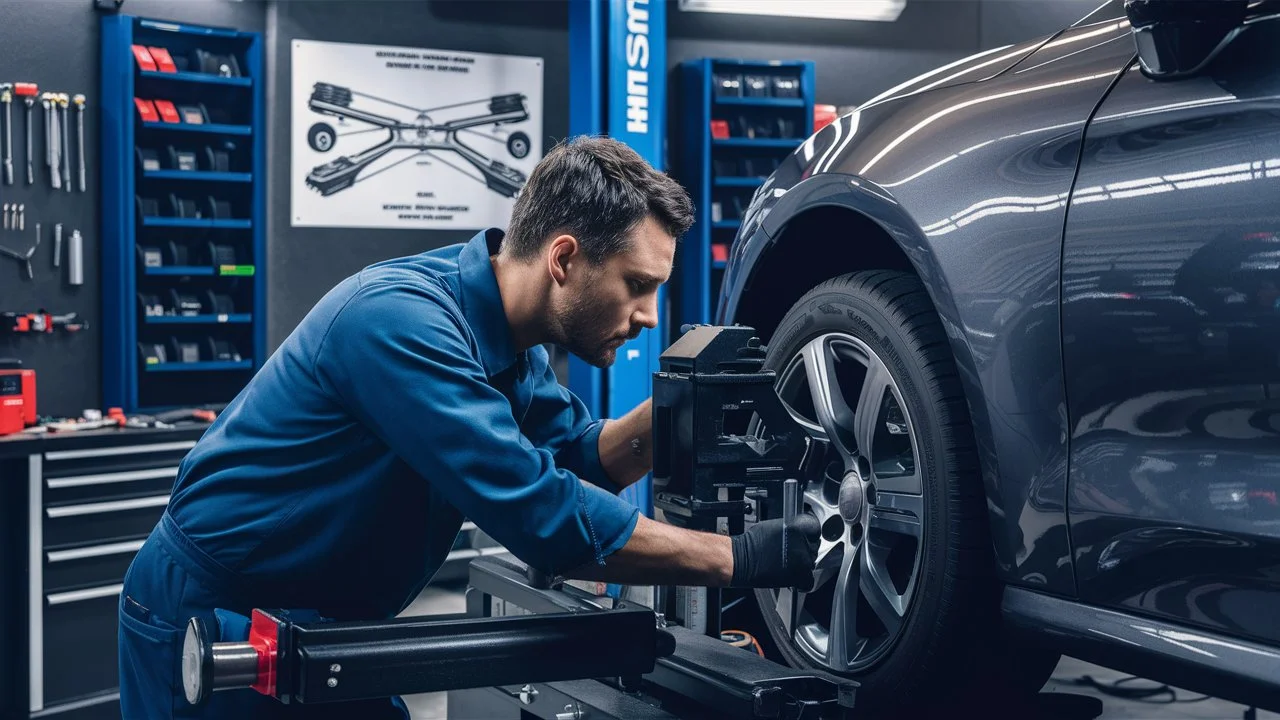 Date: July 10, 2024
Date: July 10, 2024
The need to maintain the alignment of wheels is crucial to ensuring tire life and improving fuel economy. By aligning its wheels correctly, a vehicle sets them at angles that are specified by the manufacturer as optimum. This not only increases vehicle efficiency but also influences tyre wear and fuel consumption rates considerably. In this article, we will explore how wheel alignment can help you conserve your tyres for a longer time while enhancing your car’s gas mileage.
Enhancing Tire Longevity
Proper tyre maintenance is crucial for ensuring a safe and efficient driving experience. One key aspect of this is maintaining correct wheel alignment.
_1720598155.webp)
Equal Tire Wear: Good wheel alignment ensures that tyres always wear out equally. The disparity in the alignment of the wheels makes tires wear down in an uneven manner and this necessitates early tire replacement and increased cost. A tyre with uneven wear may have one side that is less worn than the other, thus compromising its integrity and safety.
Increased Tyre Life: Alignment maintenance distributes pressure evenly over each tire, which in turn reduces overall stress on them. The result is a longer-lasting tread that increases the return on investment of top-quality tires.
Better Handling And Safety: A properly aligned vehicle boosts its maneuvering ability. If your wheels are not properly aligned, for example, you may be unable to control your vehicle from pulling in one direction when you need to—a dangerous situation especially during critical situations such as avoiding a collision. These tires are also destroyed with time but in addition, they lead to safety hazards for users.
Avoid Expensive Repairs: Failure to maintain the alignment can damage various parts of the car’s mechanics. When it comes to misalignment of wheels it has an effect on suspension systems hence requiring expensive repair services. Frequent tyre alignments and checks ensure these costs do not occur.
Optimum Tread Wear: Proper wheel alignment helps maintain optimal profiles for tread use. Misaligned wheels usually cause some parts of the tire to wear faster than others hence resulting in spots that become bald or having risks of bursting open their tubes while driving at high speeds. Equality of tread wear maintains quality conditions and durability of tyres for road use purposes.
Shield Against Road Hazards: Wheels wrongly centred can easily get damaged by potholes or dangerous road conditionings like those filled up with bumps or gravel. Good shock absorption provided by correct alignment minimizes the chances of damaging your wheels and tyres due to impacts while driving along a rough road track.
Boosting Fuel Efficiency
Proper wheel alignment not only enhances tyre longevity but also significantly improves fuel efficiency. Here’s how:
_1720598172.webp)
Decreased Rolling Resistance: When wheels are properly aligned, tires contact the ground at a beneficial angle, thus reducing rolling resistance. Lower rolling resistance is equivalent to an engine that does not work as hard, resulting in better fuel efficiency.
Optimum Engine Performance: Wheels that are out of alignment can cause the strain on the engine to increase by compensating for inefficiencies in tyre movement. This increased strain leads to higher fuel consumption. Proper alignment will ensure that the engine runs optimally and uses fuel more efficiently.
Reduced Tyre Drag: Alignment problems make tires drag instead of roll smoothly, which makes the engine work harder to maintain speed. Low tire drag, therefore, improves fuel economy.
Enhanced Aerodynamics: Vehicles with correctly aligned wheels have better aerodynamics and hence face less air resistance. This is especially true at high speeds and it contributes to saving on fuel use.
Lower Maintenance Costs: Drivers can also save on maintenance costs by improving their vehicle’s fuel efficiency through proper alignment. A less strained engine and other parts mean fewer repairs or replacements are needed.
Environmental Benefits: Better fuel efficiency is not only economical but also beneficial in lessening the damage of the vehicle to the environment. Correct positioning has the added advantage of reducing emissions; it is therefore a sustainable practice.
Importance of Regular Alignment
Regular alignment maintenance is an often overlooked but crucial aspect of vehicle upkeep. Ensuring your car's wheels are properly aligned can lead to numerous benefits, including enhanced safety, performance, and cost-efficiency. Here are key reasons why regular alignment maintenance should be a top priority for any vehicle owner.
Routine Checks: It is also important to perform alignment checks frequently for enhanced tyre durability and fuel consumption. To ensure that your wheel alignment is correct, it is recommended to get it checked every 10,000 kilometres or at least once per year. Also, any time, the tires show signs of premature wear, unusual wear, or there are vibrations or changes in handling, it is time for an alignment check.
Professional Service: Alignment maintenance must be carried out by qualified personnel. They have all the required tools and knowledge to make accurate adjustments on wheel angles as per manufacturer’s specifications.
Indicators of Misalignment: Paying attention to typical indicators of misalignment can lead to prompt maintenance. These indicators consist of irregular tyre wear, the vehicle pulling towards one side, steering wheel shake, and the wheel not being aligned while driving straight.
Impact on Vehicle Performance: Misalignment does not only influence the durability of the tyre and fuel consumption; it is also a factor in vehicle performance. Wheels need to be aligned in the right manner to improve the comfort of the ride and also the general experience of driving.
Avoiding Compounding Issues: Failure to address issues concerning proper alignment may result in compounded problems over time. Misaligned wheels can lead to damage to suspension components, steering systems as well as even the frames of vehicles. Fixing these issues quickly helps prevent additional complications arising from this misalignment.
Enhanced Resale Value: Regular alignments can also boost your vehicle’s resale value when performed regularly. Well-maintained tires and efficient fuel consumption appeal to potential customers because they show that a car has been taken care of properly.
Practical Tips to Maintain Proper Wheel Alignment
Ensuring proper wheel alignment is crucial for a smooth, safe, and efficient driving experience. While regular professional alignment checks are essential, you can take several practical steps to maintain your vehicle's alignment between visits. Here are a few tips to help keep your wheels properly aligned.
Regular Inspections: It is recommended that wheel alignments should be included in the usual check-up of the car. It can also assist in determining whether there are alignment problems at the different levels before they are serious.
Mind the Roads: Do not drive your car directly into potholes or near curbs or any other obstacles on the road as much as possible. These impacts can cause wheels to get out of alignment.
Monitor Tyre Pressure: Proper tire pressure minimizes the shift in tire alignment therefore reducing uneven wearing out of tires.
Check Suspension Components: Check that the suspension components like the shock absorbers and the struts are well maintained. The worn-out suspension usually influences the alignment.
Pay Attention to Handling: If there is any change in the behaviour of the car, it will pull to some side, or there will be vibrations on the steering wheel, then it is advised that you should get your alignment checked as soon as possible.
Rotate tyres Regularly: Tyre rotation is essential to make the wear even and check the alignment regularly. It is vital to follow the intervals recommended by your vehicle manufacturer to rotate your tyres.
Conclusion
Tyre life and fuel efficiency are highly influenced by wheel alignment and hence it is crucial in vehicle maintenance. Achieving proper alignment of wheels will help extend tire life while saving on fuel and improving overall vehicle performance. Professional alignment maintenance at set intervals is an investment that yields high returns in terms of safety, cost-effectiveness, and driving comfort.
Understanding the importance of alignment helps in arriving at the right decisions as regards the maintenance of the vehicle, hence leading to adequate reliability of the vehicle. Therefore, prioritizing alignment maintenance can help drivers meet their goals of safe and efficient use of their vehicles on the roads.
